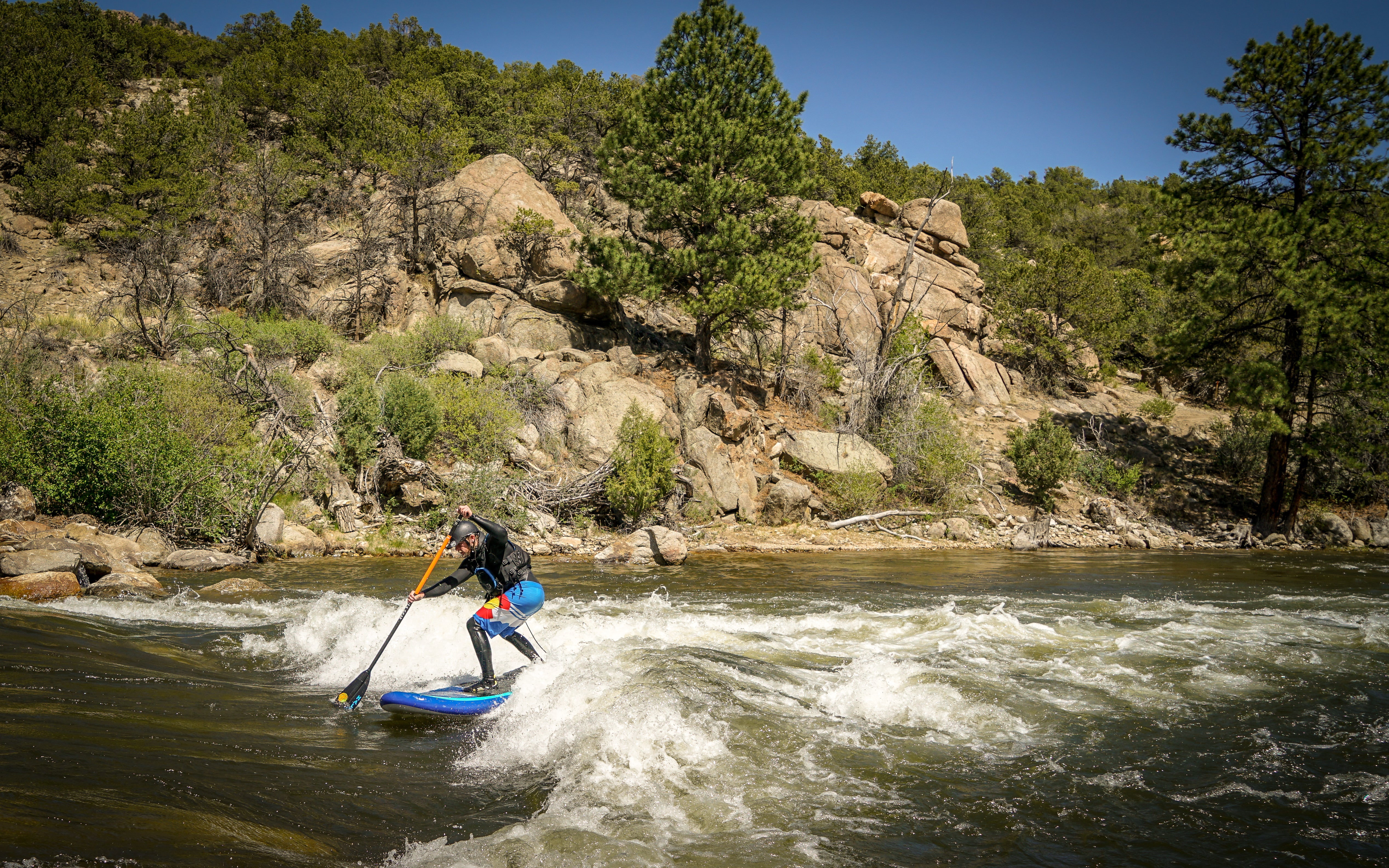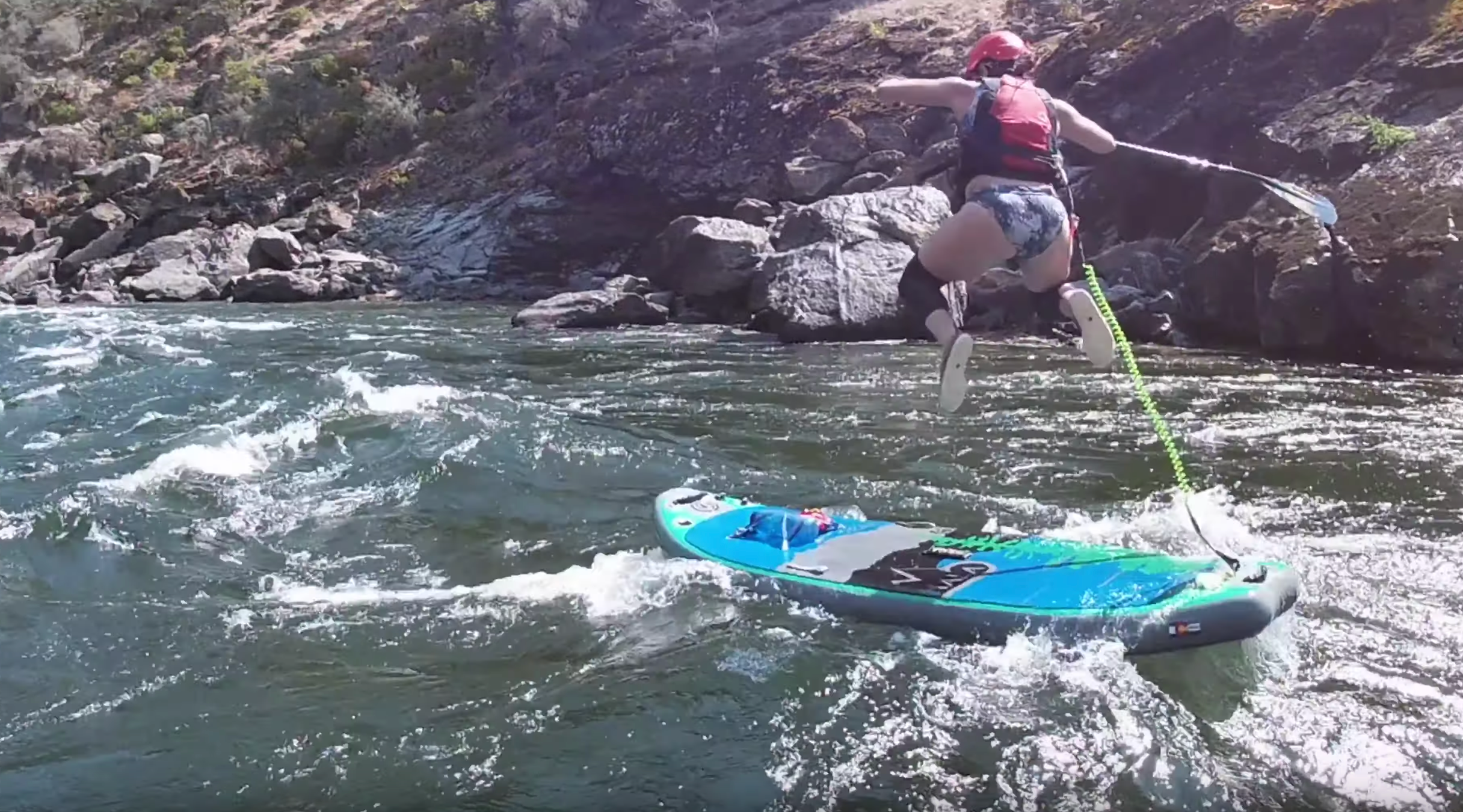
Man Explores Montana's Wild Rivers on Stand-Up Paddleboard
Jimmy Reed's affinity for whitewater didn't necessarily come naturally, even if his facilities on the river are graceful as a swan's.
Growing up on Alabama's Gulf Shore, Reed was a water kid through and through, swimming and surfing and relishing the seafarer's way of life. But it wasn't until he fell in love with the crystalline waters of Northwest Montana that his imagination for whitewater ran as wild as the region's freestone rivers.
Reed moved to the Flathead Valley in 2001 to pursue his passions for snowboarding and rock climbing. In a region distinguished by its bounty of aqueous offerings, he soon fell in with a solid crew of river rats and became infected with the contagious stoke, but when it came time to invest in his own raft, the sport's prohibitive costs gave him pause.
Then he discovered the burgeoning sport of stand-up paddleboarding and found an instant catharsis in plying the water's surface with the blade of a paddle while cruising around vertically. "It was like discovering this whole new playground on the water," Reed told the Flathead Beacon. "I was immediately hooked."
For a fraction of the cost of a rafting setup, Reed outfitted himself with a stand-up paddleboard (SUP), paddle and the basic requisite gear — PFD, neoprene booties and a dry bag to lash onto the deck of the board. Once he gained some basic chops, he began pushing into relatively uncharted waters, honing his skills on rapids and embarking on multi-day SUP expeditions.
A half-decade later, Reed's enthusiasm has grown to monumental proportions as he tours Montana's wild and scenic rivers in minimalistic fashion.
"I love just being on the water, but my true passion is being able to strap gear on my board and go touring through the wilderness," Reed said. "It's like ultra-light backpacking on the water."
A builder by trade, Reed took his interest in SUP adventures to new heights a couple years ago when he became a SUP ambassador for Hala Gear, a Colorado-based company specializing in downriver paddling and river surfing. With a quiver of inflatable SUPs, he's helping to define and revolutionize the potential for whitewater SUP, showcasing the sport's potential on the region's wildest river corridors.
This summer, Reed set out for his longest journey yet — an eight-day, 52-mile SUP-supported trip down the South Fork Flathead River, requiring at the outset a 17-mile horseback ride before putting in at Danaher Creek.
The South Fork begins deep in the Bob Marshall Wilderness at the confluence of Danaher Creek and Young's Creek. It gains volume with the contributions of the White River, Big and Little Salmon creeks, Black Bear Creek, and other small tributaries. Overall, the river flows more than 60 miles through designated wilderness and national forest lands before emptying into the Hungry Horse Reservoir.
The crux of the trip involved a run down the Meadow Creek Gorge, a roughly four-mile section of canyon between Mid Creek and Cedar Flats. Boasting four or five technical rapids, the gorge features class V rapids that are technically demanding on any craft, but especially a SUP.
For Reed, the trip was an opportunity to enjoy the untrammeled wilderness of the South Fork, but also to showcase the vast potential of whitewater river SUPing.
"That was my dream-child cruise," Reed said of the trip, which included Whitefish local Denise Hanson and fellow Hala ambassador Paul Clark, who details his international SUP adventures on his blog, suppaul.com.
With 55 pounds of gear strapped to his board, Reed said he took care to pare away unnecessary ounces to keep the board as nimble and maneuverable as possible.
"I was weighing my underwear," he said.
Reed and other SUP acolytes acknowledge that the sport won't replace class V whitewater kayaking, but paddleboarders surf big waves on high water, and frequently run the Middle Fork Flathead River or Alberton Gorge on the Clark Fork River.
"People don't realize what's possible on them," he said. "It's the perfect vessel for Class II up to Class IV and even Class V."
The biggest draw for enthusiasts like Reed is the degree of engagement with the water, which he demonstrated recently on a section of the Middle Fork above the Old Belton Bridge, on a splashy wave-train known locally as Pump House Rapid at the terminus of the river's popular commercially guided section.
To navigate the rapid, he switches his stance using a hop-turn technique with aplomb, jumping from a goofy to regular standing position depending on the line of the rapid; when he reaches the bottom of the whitewater, he pivots on a dime, turns into an eddy and paddles upstream into the rapid to surf its waves.
In this position, Reed will stand for hours on end, plying the current with the blade of his paddle, transferring his bodyweight to negotiate a swell or surf a whitewater rapid, the river's burnished bottom stones beaming a few feet below him. Each movement is smooth and controlled. If he gets tired, he can take a knee or lie down, or even stretch out into a yoga pose.
Tall and sinewy with a surfer's physique, Reed's grasp of the sport makes paddleboarding look easy. And while he claims it's so simple that anyone can learn, he says it's also versatile enough to remain challenging for experts, and physically demanding in a way that offers a low-impact workout.
"On a raft, it's like you're sitting on a couch watching the scenery go by. Whereas on a SUP, it's like being on a skateboard. You feel every ripple," he said. "The freedom to move on a paddleboard is something I really love. You're not stuck in a seat. I'm free to stand up, lounge, do yoga while I'm floating, sit down and have a snack."
Reed rides year-round, logging between 380 and 500 miles annually and averaging around 50 to 60 days, and in July alone he tallied 138 miles in just 10 days on the Flathead River's three forks.
Despite pushing his abilities, Reed is adamant about river safety.
His SUP attire includes neoprene shoes, a helmet, an insulated body suit, a signaling whistle, and a quick-release leash that attaches to his PFD. To avoid foot entrapments — the panic-inducing and potentially fatal pitfall in which a paddler's foot becomes jammed between stones or debris — Reed demonstrates how to plank out and fall flat on the river's surface.
The presence of river hazards like boulder gardens, strainers and sweepers requires constant vigilance, and on the South Fork trip, Reed and his companions scouted rapids and blind corners before running them.
"It definitely commands your attention and respect," he said.
While Reed has a bucket list of SUP expeditions he'd like to dispatch, the Flathead River's 300 miles of water has kept him busy in recent years. His favorite trips include the fly-in, float-out trip from Schafer Meadows to Bear Creek on the Middle Fork, which involved navigating numerous class III, IV and V rapids.
"That was the most technical paddling I've ever done," he said. "It's a serious chunk of wilderness."
While he's floated the entire length of the North Fork Flathead River in Montana, he hopes to journey to the North Fork's headwaters in British Columbia.
In the meantime, Reed hopes to keep raising awareness about the niche sport's potential on sections of whitewater rivers while building out the Flathead Valley's small but growing community of whitewater SUP enthusiasts.
"It's still pretty obscure, but we're an expanding tribe for sure," he said.
Article written by Tristan Scott for the Flathead Beacon. Article reposted by Jackson Hole News and Guide, MSN, and Reading Eagle.



Leave a comment
This site is protected by hCaptcha and the hCaptcha Privacy Policy and Terms of Service apply.